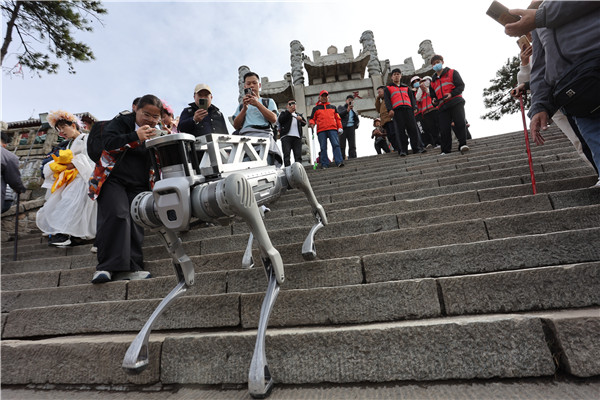Shandong to showcase agricultural strengths
Eastern Province uses expo Milano 2015 to boost exchanges, reach more European customers and improve global reputation
Shandong province, the birthplace of ancient Chinese philosopher Confucius, is preparing to host a Shandong-themed week in the China Pavilion at Expo Milano 2015, from Sept 16 to 20.
During the themed week, Shandong, one of the eight major Chinese provinces and cities to participate in the expo, will promote both its history as one of the important sources of the ancient Silk Road and its contributions to agricultural development, especially crop production.
|
Every year a Confucius memorial ceremony is held at the Confucius Temple in Qufu, Shandong. Photos Provided to China Daily |
|
Steep paths leading to the top of Mount Tai, one of China's most famous mountains, in Tai'an, Shandong province. |
|
Rizhao, a coastal city in Shandong, is one of China's major green tea production bases. |
|
A grape planting base in Yantai. The city was named "Asia's international grape and wine city" in 1987 by the International Office of Vine and Wine. |
|
Shandong's Weihai is one of northern China's biggest fishery production bases. |
"Shandong's week at Expo Milano is an important opportunity for our province to enhance exchanges and cooperation with regional governments in Italy," said Xu Qing, office director of the Organizing Committee for the Shandong-themed week at Expo Milano 2015 and head of Shandong Subcouncil of the China Council for the Promotion of International Trade.
"We will take the themed week as a good platform to showcase Shandong's unique culture and products and open-up to the European markets."
The week will include an opening ceremony, a series of trade-related events, including a meeting on trade exchanges between enterprises in Shandong and Italy, as well as a demonstration of Shandong's safety control for agricultural products.
For the trade exchange event, organized to boost industrial collaboration between Shandong and Italy as well as other European regions, more than 150 enterprises from agriculture, agricultural machinery, food processing, textile, ceramics and solar industries have been invited.
The week will also showcase Shandong's prolonged agricultural civilization through exhibitions and cultural performances.
The exhibition will include digital illustrations of a book called Qi Min Yao Shu, one of China's earliest and most important agricultural compilations written by Jia Sixie in about AD 540.
The book had profound influence on the development of the world's agricultural technology and food production after it was brought to Japan and then to Europe in the 19th century.
The exhibition is also one of the 11 regular demonstrations at the China Pavilion.
Origin of the Silk Road
With a total area of nearly 160,000 square kilometers, Shandong has a population of 97 million people.
Located on the east coast of China, Shandong faces the Korean Peninsula and Japan. It was one of the important places of origin for the ancient maritime and land Silk Road.
Archeological findings show that the Qingzhou and Laiwu regions in Shandong were among the earliest in China to develop silk products. Shandong became a starting point of the ancient maritime Silk Road more than 2,000 years ago.
Xu Qing said that Shandong established close trade relations with the rest of the world through the two Silk Road routes.
Agricultural and food cultures created by native Shandong people were also brought to different parts of the world in the process and Shandong benefited from the wisdom of other people, Xu said.
She pointed out that Shandong is integrating into the nation's "One Belt, One Road" strategy, and aims to become an important hub along the Silk Road Economic Belt and a bridgehead for the Eurasian Continental Bridge.
European cooperation
As the third biggest economy among all Chinese provinces, Shandong is one of China's most important producers, exporters and consumers of agricultural products, according to Xu.
"It has played a leading role in the country especially in international agricultural exchange," she said.
In 2014, Shandong's trade volume of agricultural products hit $42.7 billion, an annual rise of 4.2 percent.
Of that, exports of agricultural products reached $15.7 billion, 3.5 percent higher than that of 2013, making Shandong the province with the largest export volume of agricultural products in China for 16 consecutive years.
To further improve the reputation of its agricultural products both at home and abroad, Shandong is carrying out a province-wide campaign to build itself into a national model for the quality and safety control of agricultural products.
The campaign includes goals like nurturing 100 well-established agricultural brands in the province and pushing its agriculture-related export volume to $20 billion by 2017.
Shandong's competitive farm products include aquatic products, vegetables, fruits, meats and peanut products.
Its products are exported to more than 200 countries or regions globally, with Japan, the European Union and the Association of Southeast Asian Nations being its main target markets.
"The industrial structures of Italy and Shandong complement each other. Italy is an ideal partner for Shandong's enterprises to carry out foreign trade and investment, and explore the European markets," said Xu.
In 2014, Shandong's trade with Italy, the Netherlands and Sweden reached $2.64 billion, $4.65 billion and $0.78 billion.
"We will take advantage of the expo to further explore European markets for our fresh agricultural products and food products," Xu added.
To make the most of the expo and further explore the European market, a delegation of Shandong's entrepreneurs will visit and organize trade exchange conferences in the Netherlands and Sweden.
zhuanti@chinadaily.com.cn
(China Daily European Weekly 09/11/2015 page16)








 Shandong excels in advancing high-quality growth
Shandong excels in advancing high-quality growth Taishan Mountain: Sacred summit of universal harmony
Taishan Mountain: Sacred summit of universal harmony Robot dog becomes highlight of Mount Tai
Robot dog becomes highlight of Mount Tai

